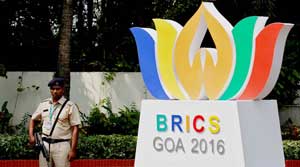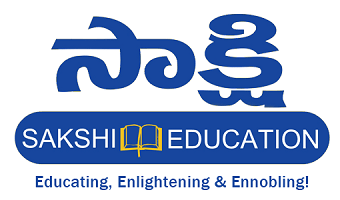BRICS: Building Responsive, Inclusive and Collective Solutions
Sakshi Education
The 8th BRICS Summit is taking place on October 15-16 in Goa under the Chairmanship of India. BRICS, grouping Brazil, Russia, India, China and South Africa is a unique international mechanism which has been playing an important role in rebalancing global influence thereby having positive effects on world economy and politics.


BRICS nations collectively account for 43% of the world population, with around 25% of the world’s total land area and close to 30 % of the GDP with around 17 % share in the world trade. These five major emerging economies are looking for their right place, in the global economic and political stage, which befits their potential and capabilities. Their rising prominence will surely help in resolving global issues in a better way.
In 2001, in a research paper on global economics titled ‘Building Better Global Economic BRICs’ which was published by Goldman Sachs, British economist Jim O’ Neill coined and used the acronym ‘BRICs’ for the first time for four rapidly developing economies-Brazil, Russia, India and China.
In 2006, Brazil, Russia, India and China began a regular informal diplomatic coordination initiative, with annual meetings of Foreign Ministers at the margins of the General Debate of the UN General Assembly (UNGA). This successful interaction led to the decision that the dialogue was to be carried out at the level of Heads of State and Government in annual Summits. The First BRIC Summit was held in Yekaterinburg (Russia) in 2009. The depth and scope of the dialogue among the Members of BRIC group – which became BRICS in 2011 with the inclusion of South Africa – kept on expanding from year to year. More than an acronym that identified countries emerging in the international economic order, BRICS became a new and promising political-diplomatic entity, far beyond the original concept which was envisioned for the financial markets.
Over the years BRICS has evolved in a phased and progressive manner, thereby very meticulously strengthening its two main pillars: (1) coordination in multilateral forums, with a focus on economic and political governance and (2) cooperation between members.
BRICS pushes for reforming the structures and forums of global governance, especially in the economic and financial fields – International Monetary Fund, World Bank, G-20 etc. There is special emphasis on the reforms of political institutions, such as the United Nations as well.
Intra-BRICS cooperation has also been solidifying with a clear and broad agenda which has been developed over the years. And this includes areas such as finance, agriculture, economy and trade, combating transnational crime, science and technology, health, education, corporate and academic dialogue and security, among others. The group is geared up to tackle challenges in the social, economic and environmental fields, and create new opportunities for the members of the BRICS group in different areas especially with an eye on the 2030 Agenda for Sustainable Development.
BRICS as well as other emerging market economies and developing countries do continue to face major financing constraints at times in addressing infrastructure gaps and sustainable development needs. To address these issues, BRICS has now under its belt, the New Development Bank (NDB) which will mobilize resources for infrastructure and sustainable development projects in BRICS and other emerging and developing economies. And to compliment the working of the NDB, the grouping also has the BRICS Contingent Reserve Arrangement (CRA), with an initial size of 100billion,tohelpcountriesforestallshort−termliquiditypressures.TheideatoestablishtheBankwasproposedbyIndiaduringthe4thBRICSSummitheldinNewDelhiin2012.Duringthe6thBRICSSummitatFortaleza(Brazil)allagreementsweresignedbyBRICSmembersandinMay2015Shri.K.V.KamathfromIndiawasappointedasthePresidentoftheNewDevelopmentBankwithitsheadquartersinShanghai(China).The7thBRICSSummitatUfa(Russia)inJuly2015markedtheentryintoforceoftheagreementontheNDB.RecentlytheBankapproveditsfirstpackageofloansworthabout811 million. The four projects in Brazil, China, South Africa and India are all in the renewable and green energy development sphere. And to quote the NDB spokesperson, “There are many more new projects in the pipeline including projects from Russia. They are at various stages of consideration or appraisal”. “NDB signifies developing countries’ coming of age; their aspirations to stand on their own feet”, the spokesperson added.
The Prime Minister of India, Shri. Narendra Modi had recently said, “BRICS acts as a vital pillar of hope for this world full of political challenges, safety related challenges and economic challenges”.
In September 2016, the BRICS leaders met informally on the margins of the G20 Summit in Hangzhou, China and according to a media note issued on this occasion, the BRICS leaders underlined the importance of further strengthening strategic partnership guided by principles of openness, solidarity, equality, mutual understanding, inclusiveness, mutually beneficial cooperation. They also underlined the importance of establishment of a just and equitable international order based on International law.
The BRICS leaders also strongly condemned the heinous acts of terrorism that continue to disrupt global peace and security and undermine social and economic confidence. They emphasized the need for a united global effort to combat terrorism in accordance with norms and principles of international law, including the UN Charter.
The leaders appreciated India’s BRICS Chairpersonship and the good pace of implementation and expansion of BRICS cooperation agenda and voiced their full support for a successful hosting of the upcoming 8th BRICS Summit in Goa under India’s Chairpersonship. They also appreciated the strengthening of people-to-people exchanges through organization of various BRICS events across the cities and provinces of India.
In New Delhi, External Affairs Minister, Smt. Sushma Swaraj while sharing India’s plan of action during BRICS Chairpersonship said, “We will adopt a five-pronged approach. It will comprise of Institution Building, Implementation, Integration, Innovation, and Continuity with Consolidation”.
On the sidelines of the 8th BRICS Summit, there will also be the BRICS-BIMSTEC (Bay of Bengal Initiative for Multi-Sectoral Technical and Economic Cooperation) Outreach Summit which will see leaders from Bangladesh, Bhutan, Nepal, Sri Lanka, Myanmar and Thailand joining the BRICS leaders.
Goa has been chosen as the venue for the 8th BRICS Summit over many other places in India. Recently the Chinese foreign Minister Mr. Wang Yi paid a pre-summit visit to Goa. After the visit, an impressed Mr. Yi said, "Goa has a time honored history, beautiful landscape, rich resources and hardworking people and is one of the most developed states in India. Goa is small, but beautiful. I believe Goa is an epitome of the future and bright prospect of India. I am sure the BRICS summit will put Goa at an even bigger stage”.
Now, the world awaits the ‘Goa Declaration’.
Source: PIB
In 2001, in a research paper on global economics titled ‘Building Better Global Economic BRICs’ which was published by Goldman Sachs, British economist Jim O’ Neill coined and used the acronym ‘BRICs’ for the first time for four rapidly developing economies-Brazil, Russia, India and China.
In 2006, Brazil, Russia, India and China began a regular informal diplomatic coordination initiative, with annual meetings of Foreign Ministers at the margins of the General Debate of the UN General Assembly (UNGA). This successful interaction led to the decision that the dialogue was to be carried out at the level of Heads of State and Government in annual Summits. The First BRIC Summit was held in Yekaterinburg (Russia) in 2009. The depth and scope of the dialogue among the Members of BRIC group – which became BRICS in 2011 with the inclusion of South Africa – kept on expanding from year to year. More than an acronym that identified countries emerging in the international economic order, BRICS became a new and promising political-diplomatic entity, far beyond the original concept which was envisioned for the financial markets.
Over the years BRICS has evolved in a phased and progressive manner, thereby very meticulously strengthening its two main pillars: (1) coordination in multilateral forums, with a focus on economic and political governance and (2) cooperation between members.
BRICS pushes for reforming the structures and forums of global governance, especially in the economic and financial fields – International Monetary Fund, World Bank, G-20 etc. There is special emphasis on the reforms of political institutions, such as the United Nations as well.
Intra-BRICS cooperation has also been solidifying with a clear and broad agenda which has been developed over the years. And this includes areas such as finance, agriculture, economy and trade, combating transnational crime, science and technology, health, education, corporate and academic dialogue and security, among others. The group is geared up to tackle challenges in the social, economic and environmental fields, and create new opportunities for the members of the BRICS group in different areas especially with an eye on the 2030 Agenda for Sustainable Development.
BRICS as well as other emerging market economies and developing countries do continue to face major financing constraints at times in addressing infrastructure gaps and sustainable development needs. To address these issues, BRICS has now under its belt, the New Development Bank (NDB) which will mobilize resources for infrastructure and sustainable development projects in BRICS and other emerging and developing economies. And to compliment the working of the NDB, the grouping also has the BRICS Contingent Reserve Arrangement (CRA), with an initial size of 100billion,tohelpcountriesforestallshort−termliquiditypressures.TheideatoestablishtheBankwasproposedbyIndiaduringthe4thBRICSSummitheldinNewDelhiin2012.Duringthe6thBRICSSummitatFortaleza(Brazil)allagreementsweresignedbyBRICSmembersandinMay2015Shri.K.V.KamathfromIndiawasappointedasthePresidentoftheNewDevelopmentBankwithitsheadquartersinShanghai(China).The7thBRICSSummitatUfa(Russia)inJuly2015markedtheentryintoforceoftheagreementontheNDB.RecentlytheBankapproveditsfirstpackageofloansworthabout811 million. The four projects in Brazil, China, South Africa and India are all in the renewable and green energy development sphere. And to quote the NDB spokesperson, “There are many more new projects in the pipeline including projects from Russia. They are at various stages of consideration or appraisal”. “NDB signifies developing countries’ coming of age; their aspirations to stand on their own feet”, the spokesperson added.
The Prime Minister of India, Shri. Narendra Modi had recently said, “BRICS acts as a vital pillar of hope for this world full of political challenges, safety related challenges and economic challenges”.
In September 2016, the BRICS leaders met informally on the margins of the G20 Summit in Hangzhou, China and according to a media note issued on this occasion, the BRICS leaders underlined the importance of further strengthening strategic partnership guided by principles of openness, solidarity, equality, mutual understanding, inclusiveness, mutually beneficial cooperation. They also underlined the importance of establishment of a just and equitable international order based on International law.
The BRICS leaders also strongly condemned the heinous acts of terrorism that continue to disrupt global peace and security and undermine social and economic confidence. They emphasized the need for a united global effort to combat terrorism in accordance with norms and principles of international law, including the UN Charter.
The leaders appreciated India’s BRICS Chairpersonship and the good pace of implementation and expansion of BRICS cooperation agenda and voiced their full support for a successful hosting of the upcoming 8th BRICS Summit in Goa under India’s Chairpersonship. They also appreciated the strengthening of people-to-people exchanges through organization of various BRICS events across the cities and provinces of India.
In New Delhi, External Affairs Minister, Smt. Sushma Swaraj while sharing India’s plan of action during BRICS Chairpersonship said, “We will adopt a five-pronged approach. It will comprise of Institution Building, Implementation, Integration, Innovation, and Continuity with Consolidation”.
On the sidelines of the 8th BRICS Summit, there will also be the BRICS-BIMSTEC (Bay of Bengal Initiative for Multi-Sectoral Technical and Economic Cooperation) Outreach Summit which will see leaders from Bangladesh, Bhutan, Nepal, Sri Lanka, Myanmar and Thailand joining the BRICS leaders.
Goa has been chosen as the venue for the 8th BRICS Summit over many other places in India. Recently the Chinese foreign Minister Mr. Wang Yi paid a pre-summit visit to Goa. After the visit, an impressed Mr. Yi said, "Goa has a time honored history, beautiful landscape, rich resources and hardworking people and is one of the most developed states in India. Goa is small, but beautiful. I believe Goa is an epitome of the future and bright prospect of India. I am sure the BRICS summit will put Goa at an even bigger stage”.
Now, the world awaits the ‘Goa Declaration’.
Source: PIB
Published date : 15 Oct 2016 04:44PM













